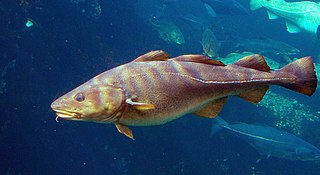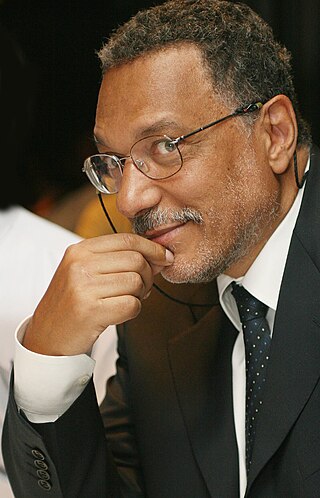Related Research Articles

Cod is the common name for the demersal fish genus Gadus, belonging to the family Gadidae. Cod is also used as part of the common name for a number of other fish species, and one species that belongs to genus Gadus is commonly not called cod.

Herring are forage fish, mostly belonging to the family of Clupeidae.

FishBase is a global species database of fish species. It is the largest and most extensively accessed online database on adult finfish on the web. Over time it has "evolved into a dynamic and versatile ecological tool" that is widely cited in scholarly publications.

A conventional idea of a sustainable fishery is that it is one that is harvested at a sustainable rate, where the fish population does not decline over time because of fishing practices. Sustainability in fisheries combines theoretical disciplines, such as the population dynamics of fisheries, with practical strategies, such as avoiding overfishing through techniques such as individual fishing quotas, curtailing destructive and illegal fishing practices by lobbying for appropriate law and policy, setting up protected areas, restoring collapsed fisheries, incorporating all externalities involved in harvesting marine ecosystems into fishery economics, educating stakeholders and the wider public, and developing independent certification programs.
The goal of fisheries management is to produce sustainable biological, environmental and socioeconomic benefits from renewable aquatic resources. Wild fisheries are classified as renewable when the organisms of interest produce an annual biological surplus that with judicious management can be harvested without reducing future productivity. Fishery management employs activities that protect fishery resources so sustainable exploitation is possible, drawing on fisheries science and possibly including the precautionary principle.

Daniel Pauly is a French-born marine biologist, well known for his work in studying human impacts on global fisheries and in 2020 was the most cited fisheries scientist in the world. He is a professor and the project leader of the Sea Around Us Project at the Institute for the Oceans and Fisheries at the University of British Columbia. He also served as Director of the UBC Fisheries Centre from November 2003 to October 2008.
The Sea Around Us is an international research initiative and a member of the Global Fisheries Cluster at the University of British Columbia. The Sea Around Us assesses the impact of fisheries on the marine ecosystems of the world and offers mitigating solutions to a range of stakeholders. To achieve this, the Sea Around Us presents fisheries and fisheries-related data at spatial scales that have ecological and policy relevance, such as by Exclusive Economic Zones, High Seas areas, or Large Marine Ecosystems.

An ecosystem model is an abstract, usually mathematical, representation of an ecological system, which is studied to better understand the real system.

The trophic level of an organism is the position it occupies in a food web. A food chain is a succession of organisms that eat other organisms and may, in turn, be eaten themselves. The trophic level of an organism is the number of steps it is from the start of the chain. A food web starts at trophic level 1 with primary producers such as plants, can move to herbivores at level 2, carnivores at level 3 or higher, and typically finish with apex predators at level 4 or 5. The path along the chain can form either a one-way flow or a food "web". Ecological communities with higher biodiversity form more complex trophic paths.

Sea cucumbers are marine animals of the class Holothuroidea. They can be used as food, in fresh or dried form, in various cuisines. In some cultural contexts the sea cucumber is thought to have medicinal value.

Ecopath with Ecosim (EwE) is a free and open source ecosystem modelling software suite, initially started at NOAA by Jeffrey Polovina, but has since primarily been developed at the formerly UBC Fisheries Centre of the University of British Columbia. In 2007, it was named as one of the ten biggest scientific breakthroughs in NOAA's 200-year history. The NOAA citation states that Ecopath "revolutionized scientists' ability worldwide to understand complex marine ecosystems". Behind this lie more than three decades of development work in association with a thriving network of fisheries scientists such as Villy Christensen, Carl Walters and Daniel Pauly, and software engineers around the world. EwE is funded through projects, user contributions, user support, training courses and co-development collaborations. Per November 2021 there are an estimated 8000+ users across academia, non-government organizations, industry and governments in 150+ countries.
Villy Christensen is an ecosystem modeller with a background in fisheries science. He is known for his work as a project leader and core developer of Ecopath, an ecosystem modelling software system widely used in fisheries management. Ecopath was initially an initiative of the NOAA, but since primarily developed at the UBC Fisheries Centre of the University of British Columbia. In 2007, it was named as one of the ten biggest scientific breakthroughs in NOAA’s 200-year history. The citation states that Ecopath “revolutionized scientists’ ability worldwide to understand complex marine ecosystems".

Fish are very diverse animals and can be categorised in many ways. This article is an overview of some of ways in which fish are categorised. Although most fish species have probably been discovered and described, about 250 new ones are still discovered every year. According to FishBase about 34,800 species of fish had been described as of February 2022, which is more than the combined total of all other vertebrate species: mammals, amphibians, reptiles and birds.

Fishing down the food web is the process whereby fisheries in a given ecosystem, "having depleted the large predatory fish on top of the food web, turn to increasingly smaller species, finally ending up with previously spurned small fish and invertebrates".

Rainer Froese is a senior scientist at the Helmholtz Center for Ocean Research (GEOMAR) in Kiel, formerly the Leibniz Institute of Marine Sciences (IFM-GEOMAR), and a Pew Fellow in Marine Conservation. He obtained an MSc in Biology in 1985 at the University of Kiel and a PhD in Biology in 1990 from the University of Hamburg. Early in his career, he worked at the Institute of Marine Sciences on computer-aided identification systems and the life strategies of fish larvae. His current research interests include fish information systems, marine biodiversity, marine biogeography, and the population dynamics of fisheries and large marine ecosystems.

The GEOMAR - Helmholtz Centre for Ocean Research Kiel (GEOMAR), formerly known as the Leibniz Institute of Marine Sciences, is a research institute in Kiel, Germany. It was formed in 2004 by merging the Institute for Marine Science with the Research Center for Marine Geosciences (GEOMAR) and is co-funded by both federal and provincial governments. It was a member of the Leibniz Association till 2012 and is coordinator of the FishBase Consortium. Since 2012 it is member of the Helmholtz Association and named GEOMAR - Helmholtz Centre for Ocean Research Kiel. The institute operates worldwide in all ocean basins, specialising in climate dynamics, marine ecology and biogeochemistry, and ocean floor dynamics and circulation. GEOMAR offers degree courses in affiliation with the University of Kiel, and operates the Kiel Aquarium and the Lithothek, a repository for split sediment core samples.
LarvalBase is a global online database of information about fish eggs, larvae and fry. It includes detailed data on the identification of very young fish and the rearing of fish species important for fisheries and aquaculture. As of July 2011, it included descriptions of 2,228 species, 4,229 pictures, and references to 4,513 works in the scientific literature. The database is under the supervision of Bernd Ueberschaer at the Leibniz Institute of Marine Sciences in Kiel, Germany.
The following outline is provided as an overview of and topical guide to fisheries:

Zebrias is a genus of ray-finned fish in the family Soleidae.
Jeffrey Polovina is an American marine scientist. He is known for creating the marine ecosystem model Ecopath.
References
- Christensen V, CJ Walters, R Ahrens, J Alder, J Buszowski, LB Christensen, WWL Cheung, J Dunne, R Froese, V Karpouzi, K Kaschner, K Kearney, S Lai, V Lam, MLD Palomares, A Peters-Mason, C Piroddia, JL Sarmiento, J Steenbeek, R Sumaila, R Watson, D Zeller and D Pauly (2009) Database-driven models of the world's Large Marine Ecosystems Ecological Modelling, 220(17): 1984–1996.
- Palomares, M.L.D., N. Bailly and D. Pauly (2009) FishBase, SeaLifeBase and database-driven ecosystem modeling p. 156–158. In: M.L.D. Palomares, L. Morissette, A. Cisnero-Montemayor, D. Varkey, M. Coll and C. Piroddi (eds.) Ecopath 25 Years Conference Proceedings: Extended Abstracts. UBC Fisheries Centre Research Reports 17(3).